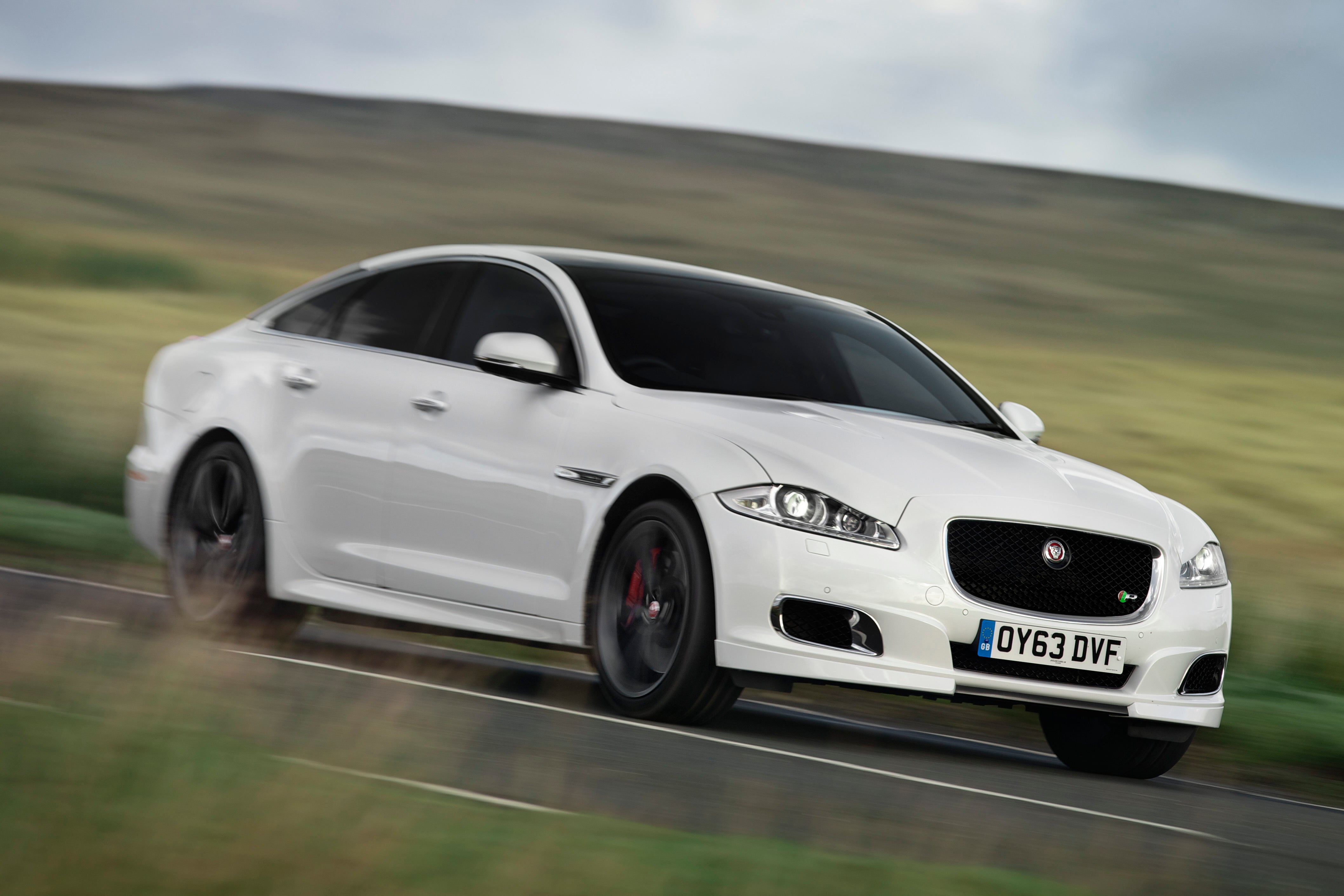Jaguar XJ Review 2025: Price, specs & boot space
Written by Al Suttie
Quick overview
Pros
- Great to drive
- Superb refinement
- Pleasingly different to German rivals
Cons
- Rear seats not as roomy as many rivals
- Patchy cabin quality
- A Jaguar XF offers almost as much for less money
Overall verdict on the Jaguar XJ
“The Jaguar XJ has always offered a very British take on the luxury saloon – one that mixes supreme comfort with more than a little sporting fun. It gives the Jaguar a unique place in this class and with plenty of appeal if you prefer to drive than sit in the back.”

Jaguar has never quite shaken off its caddish appeal from the 1950s and ’60s, and rather than worry about it, the company embraced it for this most recent generation of XJ. This is why it has more of a focus on the person sitting in the driver’s seat than the rear compared to most of its rivals, such as the Audi A8, BMW 7 Series, and Mercedes S-Class. Only the Maserati Quattroporte takes a similar path to the Jaguar but with far fewer sales to its name.
Launched in 2010, this XJ followed its more traditionally styled predecessor by using an aluminium core frame and body panels to make it much lighter than you would credit for such a large saloon. Others in this class, notably the Audi A8, take the same approach, but Jaguar used it carry on making a luxury car that was also a whole heap of fun to drive.
The light weight of the XJ for this sector also helped it return surprisingly good fuel economy and low emissions to make it appeal to company drivers and fleet users. A great many of these cars were used by private hire firms when new, so there are examples out there with very high mileages to prove the XJ is reliable, too.
Power comes from a 3.0-litre V6 turbodiesel for most XJs sold in the UK and with 275PS it can cover 0-62mph in 6.4 seconds. Top speed is 155mph, so it’s no slouch. If you want to travel even faster in near complete silence, then Jaguar also offered 5.0 V8 petrol engines with and without a supercharger, and it later added a supercharged 3.0 V6 petrol too. The ultimate model was the XJR with 550PS, which was boosted to 575PS in 2017 for 0-62mph in 4.4 seconds.
As well as the sporting XJR trim, Jaguar started out with the Luxury, Premium Luxury, and Portfolio trims, as well as standard and long wheelbase models. There was also the Supersport trim for the supercharged V8 model that sat below the XJR, which later swapped to the supercharged 3.0 V6. An R-Sport model joined the line-up in 2015.
Any XJ makes for a wonderful luxury car to drive thanks to its agile handling, refinement and power. However, there’s not as much space for legs and heads in the back of the standard XJ as you might hope, so you’ll need to the long wheelbase version if this matters to you.
Looking for a used car for sale? We've got 100s of Jaguar Approved Used Cars for Sale for you to choose from, including a wide range of Jaguar XJ cars for sale.
Is the Jaguar XJ right for you?
For anyone who values a bit of driving pleasure in their luxury car, the Jaguar XJ holds great appeal. Every version has a sporting feel to the way it corners, steers and gets down the road. It can mean the ride is not quite as cushy as a Mercedes S-Class’, but it’s a fine balance in the Jaguar between comfort and control that we like. It also has a bold look that has dated well compared to some of its rivals.
What’s the best Jaguar XJ model/engine to choose?
If it’s kids rather than adults travelling in the rear seats, the standard length Jaguar XJ is wieldier to drive than the long wheelbase version, and it’s marginally easier to park.
We’d look for the 3.0-litre V6 turbodiesel engine as it’s smooth, quiet and more than quick enough for most needs, plus the petrols can be very thirsty if you opt for the V8 motors. All come with a slick eight-speed automatic transmission from 2014-onwards, while those built before this have a six-speed auto.
The Luxury and Premium Luxury trims come with loads of comfort and labour-saving kit, but the Portfolio is the one to have. This top spec provides a rear parking camera, four-zone climate control, front massage seats, heated and cooled front seats, and a Bowers & Wilkins stereo to give that truly opulent feel.
What other cars are similar to the Jaguar XJ?
You cannot consider the luxury class without looking at the Audi A8, BMW 7 Series and Mercedes S-Class. All offer superb built, comfort, refinement, and driving dynamics, though this is aimed more at those in the rear of the car than the driver up front.
The Lexus LS offers near silent driving, helped by its hybrid power, but it’s not an engaging car to be at the wheel of. On the other hand, the Maserati Quattroporte will be a bit too energetic for many luxury car buyers with its rorty exhaust and firmly sprung suspension.
You might also consider a Range Rover as an alternative to the XJ if you want something with a higher driving position, plenty of kit, and lots of presence.
Comfort and design: Jaguar XJ interior
Starting in the driver’s seat, as this is where most XJ owners will spend their time rather than in the back. Jaguar knew this when it designed the interior and sculpted it around the driver. There’s a sweeping curve of dash that runs the width of the car and blends into the doors, giving an elegant coherence to the interior.
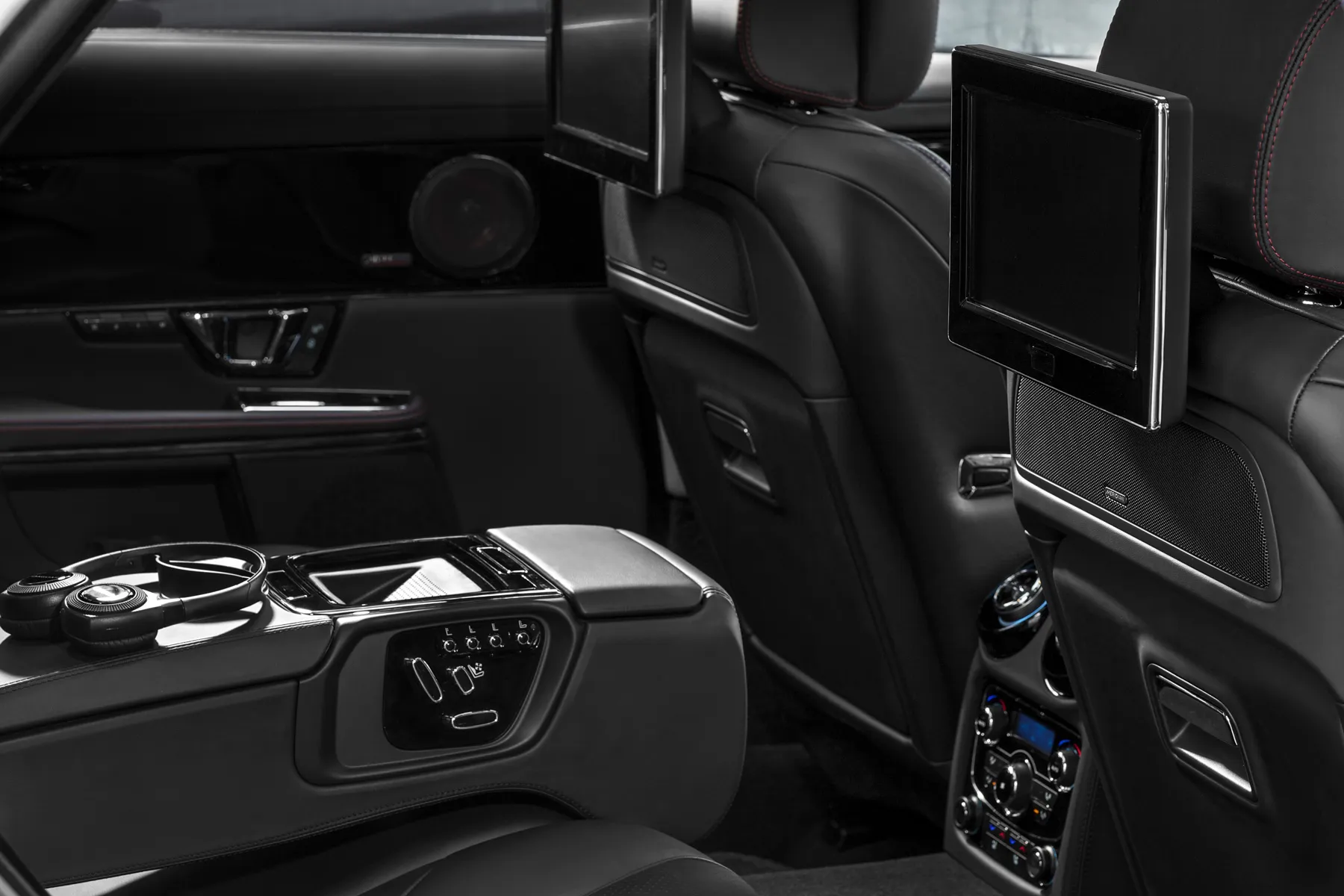
The rest of the dash is quite minimal in its look, but you have all the info you need on the TFT main screen and infotainment system in the centre console. Jaguar also stuck with separate controls for the ventilation, which is very welcome.
Thickly padded, supportive seats keep those in the front happy, while rear occupants are treated to the same. It makes for a luxurious ambience, which is enhanced by the usual mix of wood, leather than thick carpets that we expect of a Jaguar.
However, the rear seats do not provide as much head or leg room as you get in the XJ’s German rivals. It’s fine for kids, but adults will find the standard wheelbase XJ a touch cramped. This means you need the long wheelbase version to transport adults without any gripes.
Quality and finish
Jaguar threw everything at this XJ to make it as well screwed together as the competition from Germany. It worked, up to a point, as every surface you come into contact with is covered in soft leather or deeply polished wood or bright aluminium. It’s impressive and satisfying.
However, there have been glitches with the infotainment and electrics in the XJ, so it’s doesn’t have the clean sheet that a Lexus LS can boast. Still, the mix of materials and colours inside an XJ set it apart from the more clinical appearance of a Mercedes S-Class.
Infotainment: Touchscreen, USB, nav and stereo in the Jaguar XJ
The display of the central infotainment screen is less impressive than many rivals. Despite being upgraded with higher definition 8.0-inch screen in 2014, it is still a little on the small side, even compared to those of some newer family hatchbacks. It’s intuitive to operate, though, and the twin-view feature is both novel and actually useful.
In 2018, this was increased again in size to 10.0-inches when the XJ also gained a pinch and zoom function for the display. Jaguar also included a 4G wifi hotspot, but it’s also worth noting the XJ is not compatible with Apple CarPlay or Android Auto. That’s a glaring downside nowadays for most smartphone users.
Jaguar’s deal with top-end audio system manufacturer Bowers & Wilkins means that in the Portfolio trims, the XJ has one of the richest sounding stereos in the business.
Space and practicality: Jaguar XJ boot space
There are 520-litres of room in the Jaguar XJ’s boot, so it’s more than up to trips to on holiday or the golf club. You open the boot at the press of a button on the key fob, which is handy, and the aperture is wide and tall to make loading bigger bags easy.
The Jaguar XJ’s boot is bigger than a contemporary Audi A8’s, but slightly smaller than a Mercedes S-Class of the same age, though this is a little academic when they are very generous.
Handling and ride quality: What is the Jaguar XJ like to drive?
The Jaguar XJ belies its size by driving a lot like a compact sports saloon. It’s well balanced and sharp, with confidence-inspiring steering that feels simultaneously light around town but accurate at higher speeds.
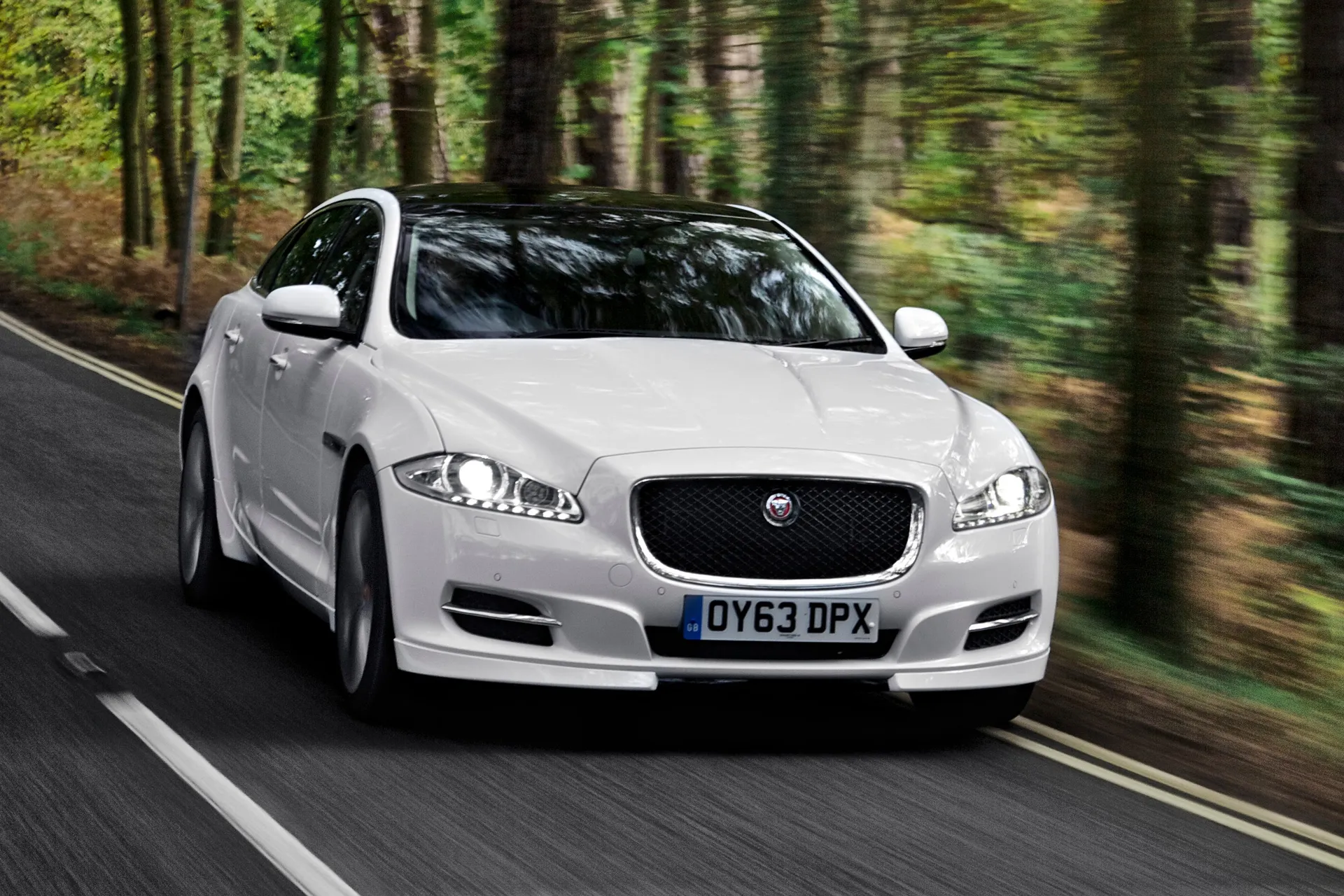
Given its comfort-oriented setup, the distinct lack of body roll during cornering is impressive too. This is a trick Jaguar has been pulling off for years, and one that no other rival has yet to match. It makes the XJ a delight to pilot on any road and also makes the car feel smaller than it is when on country roads due to its agility and responses.
A particular surprise is that the long wheelbase versions, called XJL, feel just as sharp and compact from the driver’s seat as the standard car, with the same smooth low speed ride quality. In 2014 Jaguar revised the rear suspension of the XJL models to improve their already Prime Ministerial ride quality further.
However, with higher spec versions of the XJ – called Portfolio – coming on 20-inch wheels as standard, they do suffer from a little more judder around town than those cars on smaller 18- or 19-inch wheels. Even on these smaller wheels, you will notice a slight firmness that you don’t get in a Mercedes S-Class.
What engines and gearboxes are available in the Jaguar XJ?
By far the most common engine in the Jaguar XJ in the UK is the twin-turbo 3.0-litre V6 diesel. It packs 275PS to deal with 0-62mph in 6.4 seconds and it will punt the XJ all the way to 155mph, so it’s more than brisk enough unless you want to live out a Jason Statham role in life. This motor was later uprated to 300PS.
As with all the engines in the XJ, the diesel uses an eight-speed automatic transmission that is always happy to be left to do all the hard work. You can select the manual mode, but we’d only bother with this when descending a steep hill or when feeling in a particularly sporty mood. Up to 2014, Jaguar used a six-speed automatic gearbox, which is smooth and works well but it’s not as creamily efficient as the eight-speeder.
Alongside the diesel at launch, Jaguar offered a 5.0-litre V8 petrol in naturally aspirated and supercharged forms, the latter called Supersport and packing 510PS. The standard V8 comes with 385PS and covers 0-62mph in 5.4 seconds compared to the Supersport’s 4.7 second sprint. The supercharged engine was later increased in power to 550PS for the XJR and ended up with 575PS towards the end of its life span.
The non-supercharged V8 was dropped in mid-2012 in favour of a supercharged 3.0 V6 engine with 340PS. It was swift, taking 5.9 seconds to deal with 0-62mph, but not quick or frugal enough to tempt many UK buyers away from the diesel that was more frugal and almost as quick.
Refinement and noise levels
If you want cathedral-like quiet in your luxury saloon, you should seek out the Mercedes S-Class. This is not to say the Jaguar XJ is uncouth or noisy, but there are a couple of areas where the Brit is not quite as highly polished as its key German opposition.
The most notable of these is the ride quality that has an impact on cabin refinement. Where a Mercedes glides, the Jaguar picks up on some smaller surface aberrations and translates these into a small amount of noise inside the car. It’s most prominent on XJ’s with the largest wheel sizes, but all experience this to some degree.
There is also an amount of tyre rumble heard from inside the XJ as its broad tyres cover the ground. Again, it’s not upsetting, but it is there, along with a little wind flutter at higher speeds.
The engines only make themselves known when you press hard on the throttle and even the diesel has a cultured growl entirely in keeping with the Jaguar’s image.
Safety equipment: How safe is the Jaguar XJ?
The Jaguar XJ was never tested by Euro NCAP, but it will protect you and others very well. From launch, all models came with eight airbags, stability and traction control, cruise control, ABS anti-lock brakes, and a pop-up bonnet to cushion pedestrians in the event of a collision.
From 2015, the XJ gained Jaguar’s All-Surface Progress Control to help it deal with slippery surfaces, and also added were traffic sign recognition, cruise control with queue assist, and reverse traffic warning.
In 2017, Jaguar further improved the safety offering in the XJ with lane keep assist, forward traffic detection, automatic emergency braking with pedestrian detection, and driver fatigue warning.
MPG and fuel costs: What does a Jaguar XJ cost to run?
At its launch in 2010, the 275PS twin-turbo 3.0-litre V6 diesel engine could deliver a claimed 40.1mpg combined consumption. By 2012, that figure had improved to 47.0mpg thanks to the addition of the new eight-speed auto and stop-start engine tech.
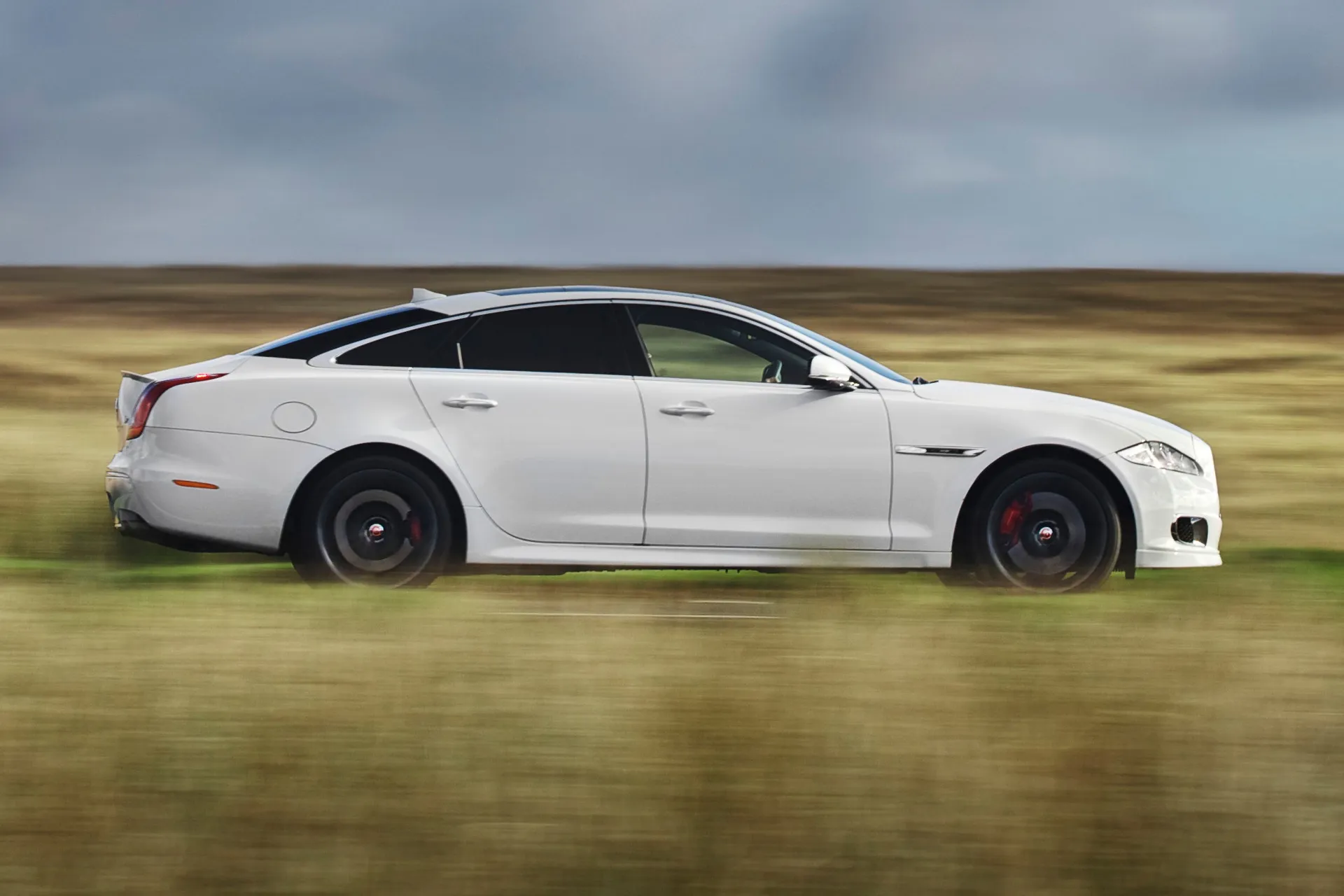
When Jaguar switched to the 300PS version of the turbodiesel motor, fuel economy jumped once more to give an official claimed consumption of 49.6mpg. In the real world, that equates to low 40s fuel economy in mixed driving, which is what you can expect from all diesel-powered XJs.
Over in the petrol corner, the 5.0 V8 could muster 24.9mpg and the Supersport a measly 23.4mpg. When the standard V8 was replaced by the supercharged 3.0 V6, the new engine made a case for itself with 30mpg economy, though this is some 17mpg behind the diesel’s. The 510PS supercharged V8 petrol offered 25.0mpg thanks to the eight-speed auto.
At the top of the XJ tree, the 575PS XJR delivers 25.5mpg combined economy, which is pretty good for a car with a 186mph top speed.
How reliable is the Jaguar XJ?
As a used buy, the Jaguar XJ is no more of a concern than any tech-laden luxury saloon. The infotainment can suffer from glitches but there are cures available.
The mechanical side of the XJ is tough and proven to last well. Servicing is needed every 15,000 miles or 12 months, and independent garages will save you a good chunk on this work.
Insurance groups and costs
There’s no getting away from the fact the Jaguar XJ will be a pricey car to get insurance cover for. The range sits in Groups 48 to 50 depending on the engine and trim, with a diesel-engined Luxury the cheapest and the super-fast XJR the most expensive.
VED car tax: What is the annual road tax on a Jaguar XJ?
For Jaguar XJs registered from 1 April 2017, you’ll pay a flat fee of £180 for road tax, plus the £390 surcharge for cars that cost more than £40,000 when new. That extra levy applied up to the car being six-years old.
For XJ sold before 1 April 2017, Vehicle Excise Duty is calculated on carbon dioxide emissions. This is fine for the 3.0 V6 turbodiesel with its 159g/km output that means you’ll pay £240. Not so good if you want the supercharged V8 with its 268g/km and £695 road tax bill.
How much should you be paying for a used Jaguar XJ?
"An early Jaguar XJ of this generation can be yours from £10,000 for a diesel or petrol version with around 80,000 miles and with full, bulging service record."
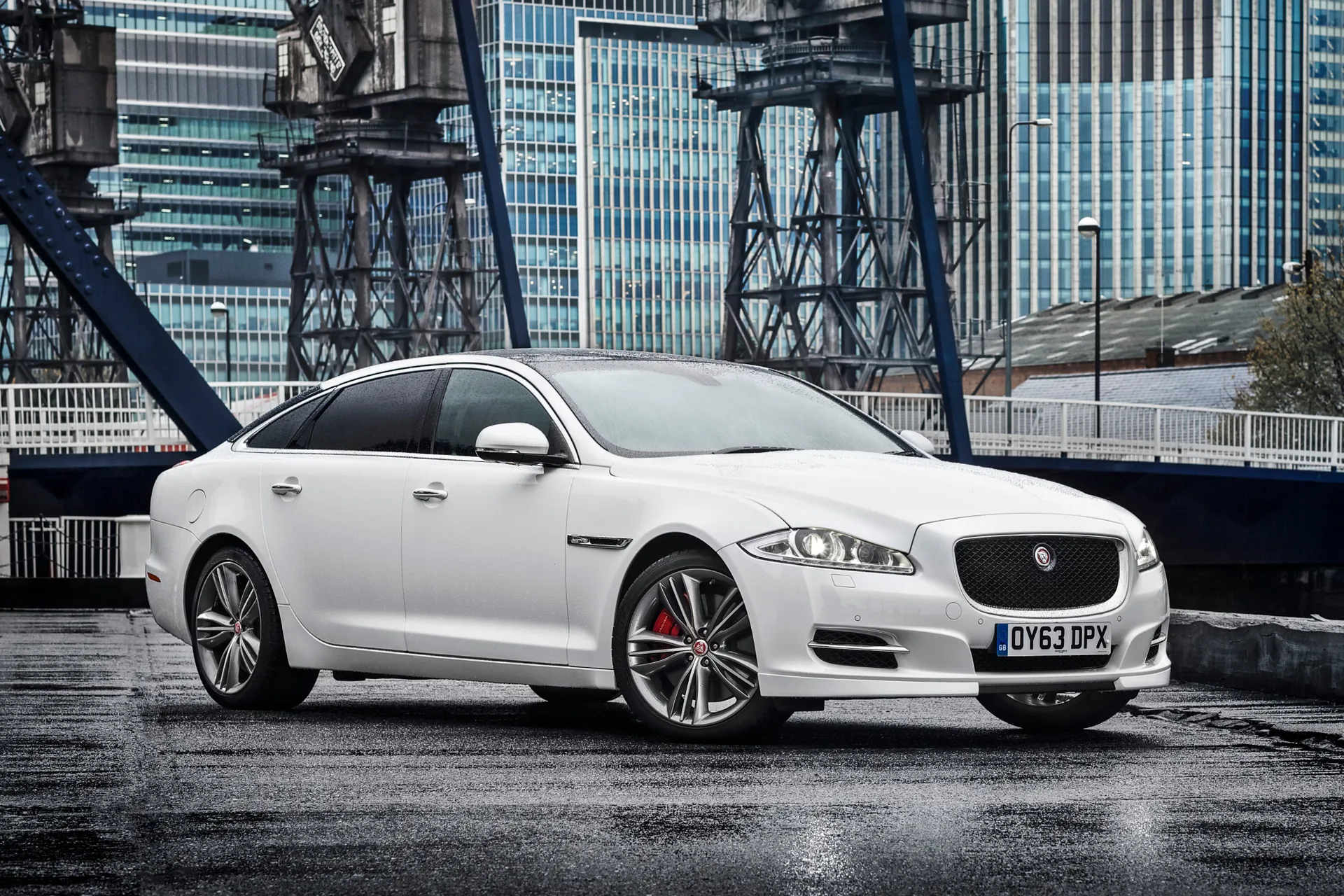
Go for a 2015 car with either the diesel or 3.0 V6 supercharged petrol motor and you’ll need to up your budget to at least £21,000. A late version of the XJ from the end of the car’s life will cost from £28,000, while the XJR commands more as prices start at £35,000 for the best low mileage specimens.
Trim levels and standard equipment
The Jaguar XJ Luxury 3.0 V6 Diesel was the entry-level model but is very well equipped. It came with Jaguar Drive Control with three modes, an electric parking brake, cruise control, rain sensing windscreen wipers, automatic xenon headlamps, LED tail lamps, acoustic laminated glass, metallic paint, 19-inch alloy wheels, keyless start, a power boot lid with customisable height adjustment, soft-close doors, and rear parking sensors. You also get electric windows, a panoramic glass roof, electric adjustment on the steering column, white and phosphor blue halo illumination and interior mood lighting, dual-zone climate control, three-spoke soft grain leather steering wheel with sequential shift paddles and remote controls for audio system. There’s cruise control, Bluetooth, leather heated front seats with electric driver's/passenger's adjustment, 12.3-inch full colour LCD instrument cluster with virtual information display, and 400W stereo.
The Jaguar XJ Premium Luxury 3.0 V6 Diesel adds 19-inch alloy wheels, front parking sensors, keyless entry, soft grain leather stitched and tailored upper fascia, door top roll and armrest. It also has heated rear seats and a 600W premium sound system with 14 speakers including two subwoofers and two front door woofers.
A Jaguar XJ Portfolio 3.0 V6 Diesel or 5.0 V8 comes with adaptive front lighting with cornering lights, 20-inch alloy wheels, a rear parking camera, a tyre pressure monitoring system, four-zone climate control, suede cloth premium headlining, and a premium carpet mat set. On top of that, there are heated and cooled front seats with 20-way electrical adjustment, front massage function and adjustable bolster, heated and cooled rear seats, and gloss figured ebony veneer. A Bowers & Wilkins 1200W premium sound system is in there with a remote power amplifier and 20 speakers, plus a multimedia system with front Dual View functionality and one set of headphones.
The Jaguar XJ Supersport 5.0 V8 S/C gets 20-inch Mataiva alloy wheels, an active differential, illuminated air vents front and rear, leather headlining, and Supersport Semi Aniline leather seats that are heated and cooled. A multimedia system has front digital/analogue television tuner and rear seat entertainment with dual 8-inch LCD screens, touchscreen remote control, and wireless digital headphones.
Jaguar’s R-Sport trim offers new side sills, three-piece front splitter, side power vents and a rear spoiler. A gloss black finish enhances the grille mesh, rear valance and the window finishers. Wheels are 20-inch Mataivia items. The interior gains sports seats, R-Sport steering wheel and treadplates, Jet headliner, and piano black trim or carbon fibre.
In the Jaguar XJR you have a sports body kit, road- and driver-monitoring adaptive dynamics, 20-inch grey alloy wheels, R-branded sports seats, contrasting coloured dashboard stitching, suede headlining, and piano black dashboard veneer.
Long Wheelbase (LWB) models add illuminated rear vanity mirrors, auto four zone climate control, rear privacy glass, rear electric blinds and side window blinds.
Ask the heycar experts: common questions
Would I better off with a Jaguar XF rather than a Jaguar XJ?
What about the reliability of the Jaguar XJ?
Is the Jaguar XJ a sports saloon?
Get our latest advice, news and offers
Keep me updated by email with the latest advice, news and offers from heycar.
By submitting you agree to our privacy policy
